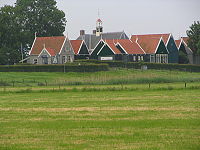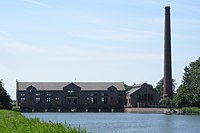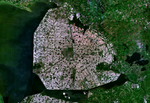World Heritage in the Kingdom of the Netherlands
| ||
World Heritage Sites in the European part of the Netherlands |
The World Heritage in the Kingdom of the Netherlands (as of 2018) includes ten UNESCO World Heritage sites , including nine World Heritage Sites and one World Natural Heritage site. One of the world heritage sites is located in the Caribbean on Curaçao . The Kingdom of the Netherlands acceded to the World Heritage Convention in 1992, and the first World Heritage site was added to the World Heritage List in 1995. The last World Heritage site to date was registered in 2014.
World heritage sites
The following table lists the UNESCO World Heritage Sites in the Kingdom of the Netherlands in chronological order according to the year of their inclusion on the World Heritage List (K - cultural heritage, N - natural heritage, K / N - mixed, (R) - on the Red List of World Heritage in Danger ) .
![]() Map with all coordinates of World Heritage Sites: OSM
Map with all coordinates of World Heritage Sites: OSM
| image | designation | year | Type | Ref. | description |
|---|---|---|---|---|---|
|
Schokland polder landscape ( location ) |
1995 | K | 739 | The settlement of Schokland symbolizes the fight of the Netherlands against the ingress of water. It shows traces of human settlement back to prehistoric times. Originally an island, it has been increasingly eroded by the Zuiderzee . Eventually it became part of the Noordoostpolders drained in 1942 . | |
| Fortress belt of Amsterdam | 1996 | K | 759 | The Defense Line of Amsterdam, called Stelling van Amsterdam , was built between 1883 and 1920 and is a unique example of a fortress based on the principle of water management. | |
| Mills in Kinderdijk-Elshout | 1997 | K | 818 | The network of mills in Kinderdijk creates an outstanding cultural landscape that is shaped by the drainage of the areas and shows all the typical features associated with this technology - dikes, barriers, pumping stations, administrative buildings and a number of windmills. | |
|
Port and downtown of Willemstad on the island of Curaçao ( location ) |
1997 | K | 819 | Founded by the Netherlands as a trading post on the Caribbean island of Curaçao in 1634, Willemstad developed continuously over the following centuries. This development is still visible today. | |
|
Wouda steam pumping station in Friesland ( Lage ) |
1998 | K | 867 | The Wouda steam pumping station near Lemmer in Friesland , which opened in 1920, formed the model for other systems around the world for many years, with both the technology and the architecture considered exemplary. | |
|
Beemster Polder ( location ) |
1999 | K | 899 | The early 17th century Beemster Polder is an exceptional example of land reclamation in the Netherlands. | |
|
Rietveld Schröder House in Utrecht ( location ) |
2000 | K | 965 | The Rietveld Schröder House in Utrecht , built in 1924 based on a design by the architect Gerrit Rietveld , is one of the most important structures of the De Stijl movement. | |
| Wadden Sea | 2009 | N | 1314 | The Wadden Sea is the largest contiguous system of a tidal zone of sand and mud flats in the world. It is considered one of the most important resting and resting areas for migratory birds in the world.
In 2014, the Wadden Sea World Heritage Site, which until then only comprised German and Dutch areas, was expanded to include large parts of the Danish Wadden Sea. |
|
| Neighborhood and canal system within the Singelgracht in Amsterdam | 2010 | K | 1349 | The Amsterdam canal belt is regarded as an exemplary architecture for the Golden Age . With the land reclamation it brought about, it was a model of urban planning and served as a reference around the world until the 19th century. | |
|
Van Nelle Factory ( location ) |
2014 | K | 1441 | The Van Nelle factory in Rotterdam , built around 1920, embodies a new type of factory, a symbol of modernity and functionalism, built in an international style . |
Tentative list
The sites that are intended for nomination for inclusion in the World Heritage List are entered in the tentative list .
Current World Heritage candidates
As of 2019, six sites are entered in the tentative list of the Kingdom of the Netherlands, the last entry was made in 2018. The following table lists the sites in chronological order according to the year they were included in the tentative list.
![]() Map with all coordinates of current World Heritage candidates: OSM
Map with all coordinates of current World Heritage candidates: OSM
| image | designation | year | Type | Ref. | description |
|---|---|---|---|---|---|
| Bonaire Marine Park | 2011 | N | 5627 | In 1971 the Bonaire Marine Park was established off the coast of the Caribbean island of Bonaire with the aim of protecting the area's marine life. In 1997 the government officially declared it a nature reserve. The marine park surrounds the entire island. The intact reefs and clear water attract around 50,000 tourists for diving and snorkeling every year.
|
|
|
Eise Eisinga Planetarium ( location ) |
2011 | K | 5629 | The Eisinga Planetarium is the oldest working model of the solar system . It was built by Eise Eisinga in Franeker from 1774 to 1781 . The model is located on the ceiling of a room and is controlled by a pendulum clock and driven by additional weight trains. The planets move in real time on long threads hanging from the ceiling. | |
| New Dutch waterline | 2011 | K | 5631 | The Dutch Waterline was an inundation-based Dutch line of defense that allowed the land to be flooded about 40 centimeters high to stop attackers. After the first inundations in the 16th and 17th centuries, a new water line was built with interruptions from 1816 to 1860. | |
| Plantations in West Curacao | 2011 | K | 5632 | includes the Ascencion, San Juan, Savonet and Knip plantations as examples of slave plantations from the 17th to the early 20th centuries.
|
|
| Colonies of Weldadigheid | 2015 | K | 6069 | The Maatschappij van Weldadigheid (Society of Charity) leased land to the poor. These lived in specially built colonies.
Transnational proposal jointly with Belgium (Ref. 5841 ). |
|
| Borders of the Roman Empire - Lower Germanic Limes | 2018 | K | 6298 | Together with Germany (Ref. 6299 ) an extension of the cultural heritage borders of the Roman Empire to the Lower Germanic Limes is being worked out. In the Netherlands, the proposal includes 26 sites along the Rhine between Berg en Dal and Katwijk .
The proposal is a revision of a proposal submitted by the Netherlands alone in 2011. |
Former World Heritage candidates
These sites were previously on the tentative list, but were withdrawn or rejected by UNESCO. Sites that are included in other entries on the tentative list or that are part of world heritage sites are not taken into account here.
![]() Map with all coordinates of former World Heritage candidates: OSM
Map with all coordinates of former World Heritage candidates: OSM
| image | designation | year | Type | Ref. | description |
|---|---|---|---|---|---|
| Middag and Humsterland | 1995-2011 | K | 461 | the cultural landscapes of Middag and Humsterland with a relatively high density of terpenes ( terps ) | |
| De Gouw and de Groetpolder | 1995-2011 | K | 463 | Area in North Holland with a high density of Neolithic Cord Ceramic settlements | |
| Swifterbant-Visvijverbos / Noordertocht ( location ) |
1995-2011 | K | 465 | Area in Flevoland with a high population density of the early Neolithic Swifterbant culture | |
| Alblasserward-Oost ( location ) |
1995-2011 | K | 466 | eastern part of the Alblasserward landscape with around 50–60 Donken . | |
|
Noordoostpolder ( location ) |
1995-2011 | K | 478 | Proposed as an extension of the existing Schokland polder landscape (Ref. 739 ) | |
|
Saba Island ( location ) |
2011-2019 | K / N | 5628 | Saba is the smallest inhabited island in the Dutch Caribbean . | |
| Zonnestraal sanatorium | 2011-2019 | K | 5633 | The Zonnestraal (sunbeam) sanatorium in Hilversum , designed by Johannes Duiker in 1926, was a clinic for aftercare for tuberculosis for diamond cutters , consisting of a main building with administration, kitchen, dining and treatment rooms and two axially symmetrical pairs of pavilions with the patient rooms. The architect's masterpiece shows structural features of the “domino system” developed by Le Corbusier . | |
| Teylers | 2011-2019 | K | 5634 | Teylers is a museum of natural and technological history founded in Haarlem in 1778 . |
Web links
- Netherlands on the UNESCO World Heritage Center website.
- Werelderfgoed in Nederland (Dutch)
Individual evidence
- ↑ Netherlands. In: whc.unesco.org. UNESCO World Heritage Center, accessed March 21, 2018 .
- ^ Tentative list of the Netherlands. In: whc.unesco.org. UNESCO World Heritage Center, accessed March 21, 2018 .
- ^ Former Tentative Sites of Netherlands. In: World Heritage Site. Retrieved March 21, 2018 .

























